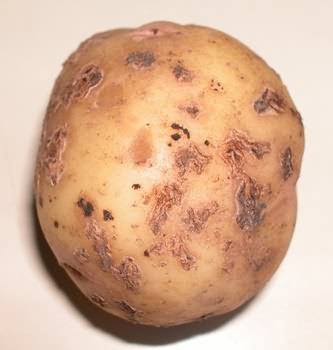Diseases
Streptomyces scabies (Thaxter) Waksman et Henrici - Common Scab of Potato
Systematic position.
Causal agents of Common Scab are actinomycete fungi. Actinomycetes have characteristic position between bacteria and fungi. The most widespread causal agent is Streptomyces scabies (genus Streptomyces).Biological group.
Soil-born pathogen.Biology and morphology.
Scab develops on tuber surface as spots with irregular margins, from several millimeters to 1 or more centimeters in diameter; the spots increase later in size and suberificate. Four kinds of Common Scab are distinguished: a flat kind (only the peel or upper layer of the periderm is affected), a convex one (the spots are bulgy or warty in appearance), a deep one (spots are sunken in tissue, with margins and brownish bottom), and a reticular kind (entire surface of tubers is coarse-reticular). Development of different kinds of Common Scab depends on depth of pathogen infection; the latter is influenced by environmental conditions and by potato varieties. Actinomycetes causing the Common Scab inhabit different organic residues and seed potato tubers in the soil. Infection of potato tubers by Scab begins when tuber formation starts. The pathogen infects the tuber directly through lenticels; infected areas on the potato respond immediately by forming a corky layer. As each new layer is invaded by the Scab pathogen the new cork forms, until a mature scab spot is produced. Mycelium of S. scabies fungus is non-septated, treelike branched. Hyphae with spirally twirled sporophores are developed on mycelium, and small-sized cylindrical oblong spores, 1.2-1.5 x 0.8-1.0 microns in size, develop on tops of sporophores.Distribution.
Disease has worldwide distribution.Ecology.
Causal agent is aerobe; optimum temperature for its development is 25 to 27.C. Low soil temperature at the time of tuber formation reduces Streptomyces development. Neutral to alkaline soil (pH 6-7.5) is favorable for Potato Scab development. Potato growing on loamy and sandy soil with alkaline pH is often highly affected. Dry and hot weather also promotes an increase of the disease development.Economic significance.
Severe damage worsens the quality of tubers. Scab tubers have bad taste and poor market quality because of lower starch concentration. Tubers infected with Scab are more often invaded by moulds. Strongly affected tubers have low germinating capacity and are unsuitable for planting. Protection measures include: use of disease-free seed tubers, disinfection of the seed tubers, growing of resistant varieties, testing the pH of the soil, crop rotation, and application of green manure crops for fertilization.Reference citations:
Bus.ko I.I. 1990. Features of pathogenesis of Common Scab of Potato and development of protection measures in Byelorussia. Abstract of PhD thesis. Minsk: Samokhvalovichi. 20 p. (In Russian)Denisenko V.A. 2000. Common Scab of Potato. Akhova Raslin, 3: 23-24. (In Russian)
Ivanyuk V.G., Busko I.I. 1990. Caused agents of Common Scab of Potato and protection measures in Byelorussia conditions. Samersov V.F., ed. Collection of repots of Byelorussian research institute of plant protection. V. 15. Minsk: Uradzhai. 58-63 p. (In Russian)
Peresypkin V.F. 1989. Agricultural phytopathology. Moscow: Agropromizdat. 480 p. (In Russian)
Popkova K.V., Shneider A.S., Volovik A.S., Shmuglya V.A. 1980. Diseases of potato. Moscow: Kolos. 304 p. (In Russian)
Sedova V.I. 1999. Common Scab of Potato. Zashchita rastenii i karantin, 5: 18. (In Russian)
Volovik A.S., Litun B.P. 1975. Harmfulness of potato diseases. Zashchita rastenii, 7: 4-6. (In Russian)
© Gultyaeva E.I., Levitin M.M.


